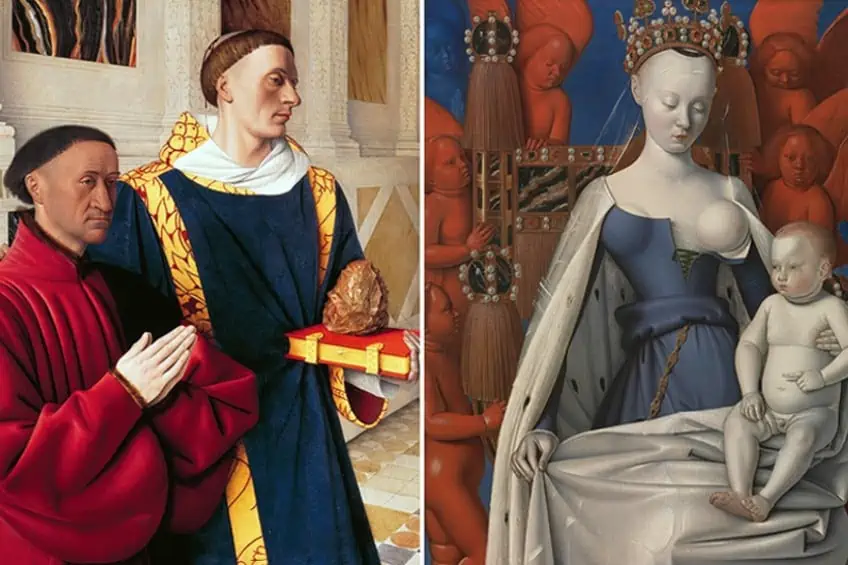Diptych Art – Discover the History of Famous Diptych Artworks
What is a diptych artwork? According to the diptych definition, a diptych is any artwork with a couple of flat plates that constitute one art piece, and are typically joined by a hinge. Let’s find out more about the history of diptych artwork, as well as analyze a few famous diptych paintings.
What Is a Diptych Artwork?
The traditional school notebook of the ancient world was a diptych composed of a couple of these plates with a gap stuffed with wax. When the annotations were no longer required, the wax could be softly warmed and flattened, allowing reuse. Normal diptychs featured wooden frames, while more opulent diptychs were made of more pricey materials. A diptych artwork consists of two panels that together make a single work of art. These can be joined together or presented adjacently.
Panels were frequently hinged in medieval times so that they could be shut and the artworks safeguarded.
The History of Diptych Artworks
The “consular diptych” was created to commemorate a person’s appointment as a Roman consul when they appear to have been prepared in sets and given by the incoming consul to acquaintances and followers. These ivory notebook diptychs had covers etched in low relief on the outer covers. Others could have been commissioned for personal use or created to celebrate a wedding. Numerous diptych artworks, some of the most significant extant artworks of the Late Roman Empire, have been inverted and repurposed as book covers in order to preserve them.
The biggest Byzantine ivory panel still in existence is a leaf from a diptych painted in the Justinian court style around 550 CE and depicting an archangel.
From the Middle Ages onwards, numerous panel artworks assumed the diptych format, as compact artworks for personal purposes; Eastern Orthodox versions were dubbed “traveling icons”. Although these triptychs were more prevalent, there were also ivory diptychs with relief-carved religious subjects, a form that originated in Byzantine artwork before becoming highly popular in the Gothic era in the West, when they were mostly created in Paris. These fit the nomadic lifestyles of medieval nobility. The ivories favored compositions with several vertical levels crammed with little characters.

By the 15th century, one panel (typically the left one) may have a profile head of the proprietor or client, with the Virgin Mary or some other religious theme on the opposite side. The exteriors, which sometimes incurred significant damage from travel, can feature simpler ornamental motifs, such as the owner’s coat of arms. Large altarpieces were typically fashioned in the shape of a triptych, having two outside panels that could be folded across the central depiction. They are a sort of multi-panel artwork known as a polyptych. The diptych was a popular genre in Early Netherlandish art, depicting anything from secular portraits to religious figures and tales. A leaf was frequently added to a picture, such as a Virgin and Child.
It was notably popular throughout the 15th and 16th centuries. The format was utilized by artists such as Rogier van der Weyden, Jan van Eyck, Hans Memling, and Hugo of der Goes.
Some contemporary painters have used the concept in the title of artworks comprised of two artworks that are never truly joined by a hinge but are designed to be displayed close together as a set, for example, Marilyn Diptych (1962) by Andy Warhol. which has become a modern pop culture symbol. The term “diptych” is frequently used to describe a complementary pair of movies or works of literature. They are considered as illuminating each other and composing a separate piece of art from the various elements when combined together.
Ecclesiastical Diptych Artworks
The term “diptychs” first appears in early Christian literature in this form. The term applies to official lists of the alive and deceased kept by the local church. The living would be engraved on one side of the diptych, while the deceased would be engraved on the other. Etching a bishop’s name in the diptych indicates that the local church believes itself to be in union with him; removing a bishop’s name indicates that the local church has broken its connection with him. The priest would recite the names in the diptychs throughout the Divine Liturgy, and the cleric would read them at the Liturgy of Preparation. Diptychs were frequently used to immortalize saints’ names.
Even though the wax tablets are no longer utilized, the phrase is still used to represent the texts of the diptychs in the Eastern Catholic and Eastern Orthodox Churches, with all of the same associations.
Diptych Sundials
Each leaf had a face on the inside. One leaf made a horizontal sundial, while the other made a vertical sundial. The shadow caster was a thread between them, calibrating how far they should open since the angle is crucial. A sundial of this type may be modified to any latitude by orienting its shadow caster parallel to the Earth’s axis of rotation. A widespread misconception is that if both displays show the same time, the instrument is appropriately positioned and faces north.
A Diptych constructed as described above as a combined horizontal and vertical sundial with a thread shadow caster will display the very same time on each dial regardless of its orientation.

Traditionally, this virtue of self-alignment was only valid for diptychs made up of a vertical and an analemmatic sundial. Certain diptychs had crude calendars in the style of pelekinons that were synchronized to a nodus in the shape of a knot on the string. These are precise to approximately a week, which was sufficient to time crop planting.
Famous Diptych Paintings
The diptych was employed by artists to convey a tale at different moments in time, to portray the growth of an individual, or to represent many points of view. For many years, the diptych, whether painted or sculpted, was the primary option for representing religious art. Nonetheless, diptych artworks appear often in subsequent classical and modern art.
The Wilton Diptych (c. 1399) by Unknown Artist
| Artist | Unknown (c. 1390s) |
| Date Completed | c. 1399 |
| Medium | Egg tempera on Baltic oak |
| Dimensions (cm) | 53 x 37 |
| Current Location | The National Gallery, London, United Kingdom |
The Wilton Diptych was created on two pieces of Baltic wood that were put in the framing of the same material and linked by a couple of hinges so that the inner artwork can be protected. Although some glazes have been damaged, the inside surfaces of the panels are in outstanding condition for their age, but the exterior faces show paint loss from handling. Tempera is used in this diptych artwork, with ground paint combined with egg yolk and applied in thin glaze layers. Gold leaf is inlaid in the background and several foreground details, and the surface has been crafted beneath the gold in places to accentuate the aesthetic quality.
Despite the fact that the people in the two interior scenes face each other and connect through look and gesture, they are placed in distinct environments.

The humans are on bare rocky terrain, with a forest in the background and a gold leaf “sky” embellished with a metallic punch design. The heavenly beings stand in a beautiful field, with a gold backdrop patterned by a distinct punch behind them. The kneeling King Richard II is represented in the left-side panel by Edward the Confessor, and Edmund the Martyr, each bearing his own attribute. The Virgin, holding the Child, is flanked by 11 angels in the right-hand panel, which is set against a golden backdrop and a field of finely colored flowers.
Although the two images are conceptually related, their compositions have very different feelings. The scenario with Richard and his guests is calm but full of vibrant color and texture variations.
The Annunciation and the Visitation (1399) by Melchior Broederlam
| Artist | Melchior Broederlam (1350 – 1409) |
| Date Completed | 1399 |
| Medium | Tempera on wood |
| Dimensions (cm) | 167 x 125 |
| Current Location | Musée des Beaux-Arts, Dijon, France |
Broederlam made an effort to evenly distribute painted shapes throughout all the open spaces. The viewer may gaze beyond the central theme to the depths of the landscape and architectural elements in the backdrop, in addition to the focal motif which is laid out on a decoratively structured plane. In a Gothic hall that is open on both sides, the Virgin greets the angel; close by, there is a structure with a circular ground plan. A hallway connected to this structure can be seen running perpendicular to the picture’s horizontal axis and concluding at an Italian-style, two-story building.
The architectural assemblage is arranged fairly haphazardly because the artist sought to employ the fundamental forms to convey complex symbolic notions.
For instance, the Old Testament is represented by the rather oriental, vaulted cathedral, while the New Testament is represented by the Gothic hall. Elizabeth and Mary meet in front of a barren, rocky, mountainous terrain on the panel’s right side. The backdrop expands into depth while also filling the picture’s surface and conforming to the wavy lines of the frame. The two scenes’ surroundings have been given unity by the artist in a number of different methods. One of these is the choice to show the angel in a natural environment.
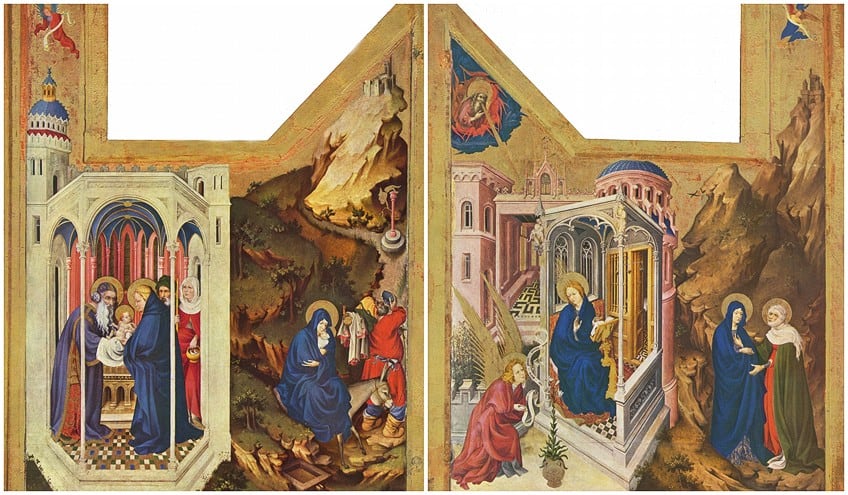
He contrasted the brown ground outside of the building cluster with the beautiful flower garden on the left side of the image, yet the natural surroundings are linked with the stone structures in this way. The two components of the composition are also cleverly integrated, with the mountain’s flat plateau slotting into the ledge of the circular building. The Virgin is the stationary character on either side, with Elizabeth and the Archangel Gabriel approaching her from opposing directions.
The round line of the cliff in the foreground of the landscape, as well as the construction of the edifice with the obliquely situated hall, accentuate the route of their movements.
The Melun Diptych (1455) by Jean Fouquet
| Artist | Jean Fouquet (1420 – 1481) |
| Date Completed | 1455 |
| Medium | Oil on panel |
| Dimensions (cm) | 93 x 85 |
| Current Location | Gemaldegalerie, SMPK, Berlin, Germany |
Etienne Chevalier, King Charles VII’s treasurer, commissioned this two-panel devotional artwork after having seen another piece by Jean Fouquet. The latter was embellished with tiny versions of the Trajan’s Column, the Old St. Peter’s Basilica, and other landmarks that Fouquet had seen while visiting Rome with which Chevalier, a former Ambassador of France in England, would have been aware.
Fouquet was probably already thought of as the best artist at the French Court at Tours. While in Rome, he was given the opportunity to produce the portrait of Pope Eugenius IV.
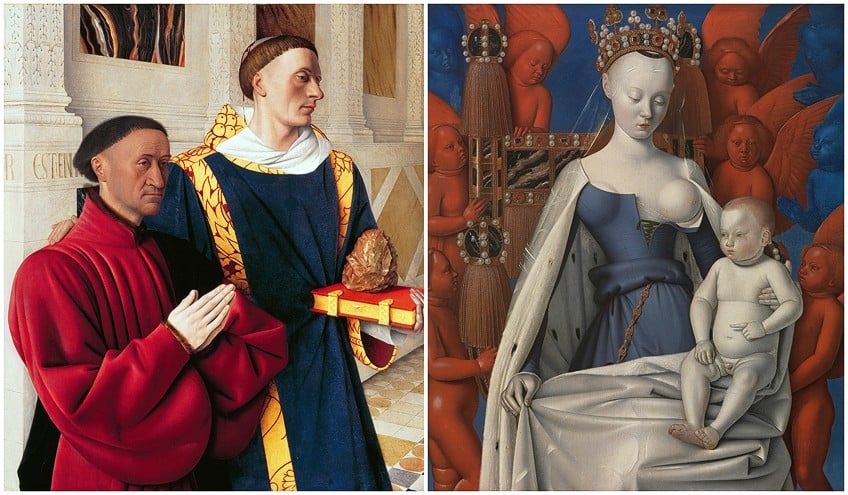
Earlier, he had completed the portrait of France’s Charles VII – another classic of early French art though not particularly flattering since it revealed the King’s large nose and pop-eyes. Fouquet got contracts from the province of Tours in addition to Chevalier and the king, as well as from other high officials including Guillaume Jouvenel des Ursins, the chancellor. The donor is shown knelt with Stephen, his patron saint, in this diptych artwork.
In a deacon’s gown, the saint is carrying a book with a jagged stone as a reminder of his martyrdom, and blood is dripping from the spot where he was killed – the top of his head.
Diptych of Federico da Montefeltro and Battista Sforza (1466) by Piero Della Francesca
| Artist | Piero Della Francesca (1415 – 1492) |
| Date Completed | 1466 |
| Medium | Oil on wood |
| Dimensions (cm) | 47 x 33 |
| Current Location | Uffizi Gallery, Florence, Italy |
The diptych depicts the wife of the Duke of Urbino and is one of the most well-known portraits of the Italian Renaissance. The noble couple appears emotionless thanks to the 14th tradition, which was inspired by the styling of ancient coins. The two people are shown in profile, a perspective that guaranteed a good likeness and a truthful portrayal of facial specifics without letting their sentiments show through. The pair are facing each other, and the background’s light and continuous, undulating countryside, which represents the region of the Marches they dominated, implies a spatial element.
It is noteworthy how the light skin tones of the Duchess contrast with the golden tones used for the Duke; her light pallor not only adheres to the aesthetic standards that were popular throughout the Renaissance, but it may also be a reference to her early death in 1472.
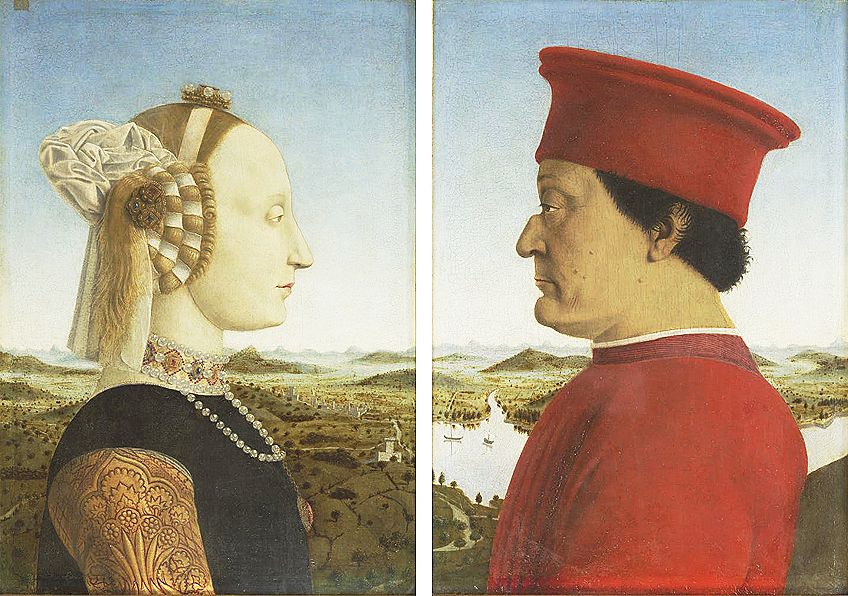
The Latin inscriptions on the rear of the boards honor the couple’s moral principles by depicting them being triumphantly pulled by wheels while being escorted by the Christian virtues. The appearance of the pictures on the back implies that the two paintings, which are currently housed in a contemporary frame, were formerly a diptych. The twin portrait, one of Della Francesca’s most well-known pieces, represents the connection between the painter and the Montefeltro kings; he was a regular visitor to their court, which would soon become one of the most significant centers of Italian culture and the arts.
In order to achieve astonishing results and unrivaled uniqueness, the master artist combines the rigid application of perspective he had learned during his Florentine studies with the lenticular depiction more typical of Flemish paintings.
The Sculptor Aubé and His Son, Emile (1882) by Paul Gauguin
| Artist | Paul Gauguin (1848 – 1903) |
| Date Completed | 1882 |
| Medium | Oil on canvas |
| Dimensions (cm) | 53 x 72 |
| Current Location | Petit Palais, Paris, France |
Paul Gauguin, who is most renowned for his early canvases depicting his life in Polynesia, is also the artist of this famous diptych painting. This diptych artwork differs from his other work in that the colors are muted and the themes are not unusual. Aubé may be seen on the right working on a vase at his workshop. Instead of continuing what he is doing, he turns to face his child, who is gazing at images in a completely different scene than the one he is now in. The father and son are positioned opposite one another and don’t seem to be close to one another. However, the two canvases merge into one another.
Even the flower vase and the edge of the table where the artist is engaged appear in the scenario with his child. Gauguin thus distances himself from the Impressionist movement and the concern with imitation.
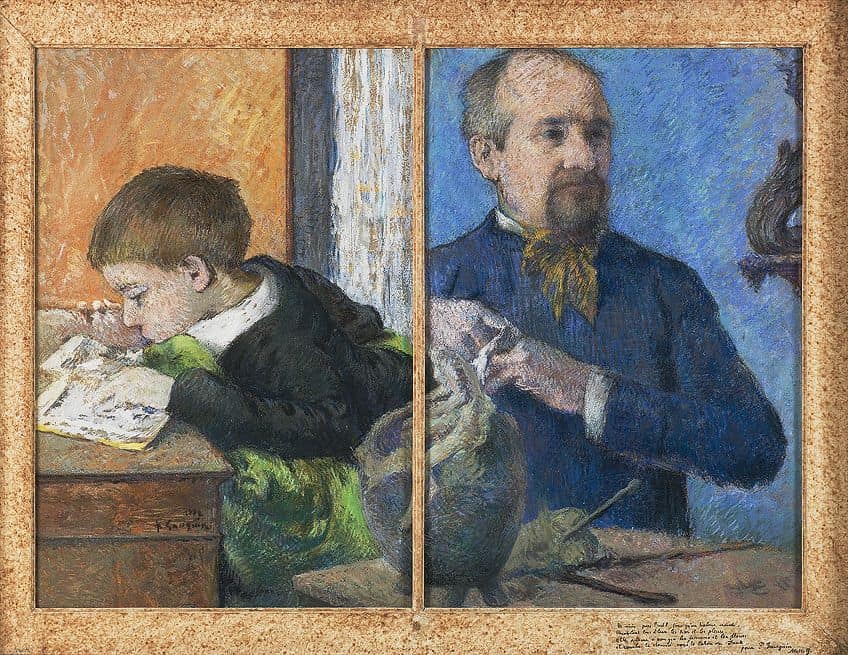
Based on the diptych definition, a diptych is a work of art composed of two sections. It might be a sketch, a painting, a picture, a carving, or any other type of flat artwork. Diptychs have long been a favorite option among painters. Typically, the two panels are intimately connected to one another; although a diptych can also refer to a single work that is spread across two independent panels. A landscape artist, for instance, may opt to paint the subject on two panels, which are subsequently shown together.
Frequently Asked Questions
What Is a Diptych?
Diptych artworks were traditionally hinged similar to old book volumes that could be bent. Artists in modern art frequently make two different panels intended to be displayed next to one another. Other painters may use a single panel to give the appearance of a diptych. This may be accomplished in a variety of ways, such as with a painted line dividing the piece or with a single mat with two openings cut into it.
What Is a Triptych?
While researching diptych artworks, you may have also come across the word triptych. That’s because the two formats are quite similar – they consist of multiple parts. The difference, however, is that a diptych is comprised of two parts, and a triptych has three.
Jordan Anthony is a Cape Town-based film photographer, curator, and arts writer. She holds a Bachelor of Art in Fine Arts from the University of the Witwatersrand, Johannesburg, where she explored themes like healing, identity, dreams, and intuitive creation in her Contemporary art practice. Jordan has collaborated with various local art institutions, including the KZNSA Gallery in Durban, the Turbine Art Fair, and the Wits Art Museum. Her photography focuses on abstract color manipulations, portraiture, candid shots, and urban landscapes. She’s intrigued by philosophy, memory, and esotericism, drawing inspiration from Surrealism, Fluxus, and ancient civilizations, as well as childhood influences and found objects. Jordan is working for artfilemagazine since 2022 and writes blog posts about art history and photography.
Learn more about Jordan Anthony and about us.
Cite this Article
Jordan, Anthony, “Diptych Art – Discover the History of Famous Diptych Artworks.” artfilemagazine – Your Online Art Source. March 20, 2023. URL: https://artfilemagazine.com/diptych-art/
Anthony, J. (2023, 20 March). Diptych Art – Discover the History of Famous Diptych Artworks. artfilemagazine – Your Online Art Source. https://artfilemagazine.com/diptych-art/
Anthony, Jordan. “Diptych Art – Discover the History of Famous Diptych Artworks.” artfilemagazine – Your Online Art Source, March 20, 2023. https://artfilemagazine.com/diptych-art/.


